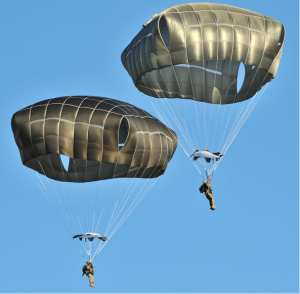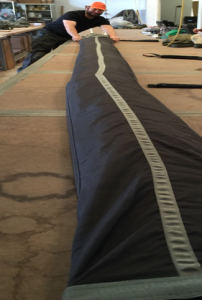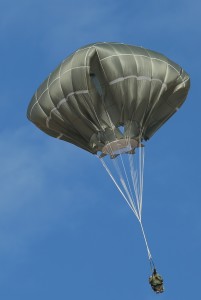T-11-The parachute with a sleeve. Made in the USA.
Mary Slaughter Asociate Scientist, Advanced Materials Group

Have you ever considered skydiving? Army paratroopers routinely jump from aircraft using a T-11 parachute system that is the next generation in non steerable parachute systems in use by the United States Armed Forces. This system is comprised of a 38 pound main chute and harness along with a 15 pound reserve assembly plus full combat equipment, designed to withstand a total weight of 400 lb including the paratrooper. There are new improved features of the T-11 compared to the old T-10, which has been in use since the 1950’s, including a sleeve deployment system that allows for more space between parachutes through the deployment and canopy inflation process (Figure 1). Therefore, the chance for midair collision and entanglement is greatly reduced.1 The cotton sleeve has a second critical purpose to mitigate any thermal damage caused by friction between the thin nylon canopy and suspension lines during rapid deployment. A paratrooper’s life depends on proper inflation of the canopy without any damage. High strength cotton that is produced in the US is increasingly more difficult to obtain. It is essential for the Army to find alternate materials to meet Berry Amendment (“Made in USA”) that have comparable performance to cotton. This material must minimize friction and effectively dissipate heat away from the canopy.

Through a research program funded by the US Army through the SBIR program, Luna’s team is in the process of developing a new sleeve that is low cost, durable, and protects the canopy from damage by reducing the frictional forces during deployment. Luna’s knowledge and background in textile treatment development has been instrumental in producing a low friction formulation that will significantly lower the coefficient of friction of the selected fabric. This new fabric with a low friction surface will lessen the chances of thermal or mechanical damage to the canopy during deployment. After subscale demonstration in our laboratories, Luna partnered with Airborne Systems to produce full scale T-11 parachute sleeves to evaluate the materials in the field through aircraft drop trials. In the Arizona desert, Luna participated in the evaluation using our prototype low friction sleeves compared alongside currently fielded parachute systems from a test aircraft at 120 knots, 1000 ft altitude to observe the deployment process. It is amazing how fast this huge canopy inflates within a couple seconds to the large square in the sky (Figure 3). There is no need to worry about risk jumpers testing Luna sleeves because this early phase involves using a 390 lb metal dummy. This initial evaluation was highly successful leading to more extensive testing to qualify this replacement material including live jumps in the near future.
